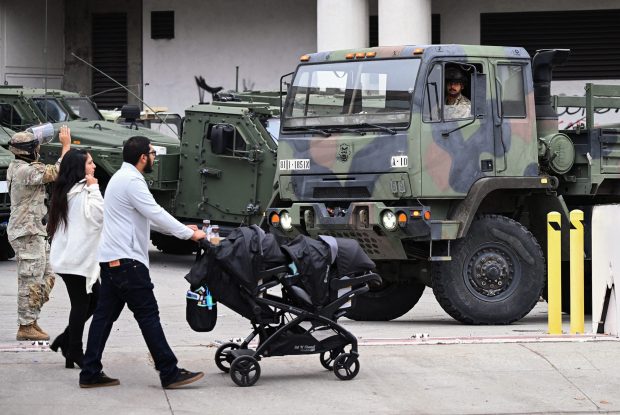The U.S. consumer is increasingly tapped out, and the effects are being felt in even the strongest, most resilient brands out there. Exhibit A is Starbucks.
The Seattle-based coffee chain, ubiquitous in the U.S. and increasingly a truly global franchise, on Wednesday laid one of the biggest eggs it ever has on Wall Street with a first-quarter earnings report that sent many investors running for the exits like their caramel frappuccinos were on fire. The stock closed down nearly 16% on more than eight times the average trading volume.
We could bore you with the numbers, but suffice to say there was investor shock over a brand that has known decades of robust growth reporting a 4% year-over-year decline in same-store sales. The obvious concern: Have U.S. consumers (not to mention those in China and other countries) finally hit a limit on how much they will pay for a cup of coffee?
Starbucks has defied this concern for decades, deftly pitching its offerings as premium experiences even as the company’s footprint expanded relentlessly into what now seems like every hamlet or street corner in the country. In some cities, it feels like even the Starbucks have Starbucks. Can a product be considered special when it’s available everywhere?
That question was particularly front of mind Wednesday when company executives pinned a good part of their first-quarter woes on “occasional” customers making a Starbucks visit a much rarer occurrence than had been the case before. The hardcore Starbucks loyalist remains steadfast, they said, trying to reassure fretful analysts. The problem? Everyone else.
Occasional customers, CEO Laxman Narasimhan told analysts, “are clearly making choices based on the economic pressures they face.”
To be clear, Starbucks isn’t the only fast-food or convenience brand whipsawed by sour consumer sentiment. Yum Brands’ KFC and Pizza Hut brands reported same-store sales declines of 7% and 6%, respectively, in the U.S. McDonald’s, the 800-pound gorilla of the sector, managed 2% same-store sales growth in the quarter, but its executives told analysts they were surprised by how quickly consumers in the U.S. (and in other countries) have tightened their belts in 2024.
One can discern quite a bit from the fast-food and convenience-dining sectors in terms of the state of the economy and even politics. Last year, the economic narrative focused on the remarkably resilient U.S. consumer, still cheerily spending away despite inflationary pressures and relatively high interest rates. Central bankers were getting preliminary plaudits for battling inflation to a standstill through higher rates without suffering the corresponding recession we usually do in such campaigns.
Now? The consumer is fraught, the Biden administration’s economic bragging points are undermined and a presidential election is approaching amid broad public unhappiness with their electoral choices and the state of the country.
In the past, when consumers got nervous about the economy and their household budgets, McDonald’s and other fast-food purveyors would thrive. After all, those options were affordable alternatives to a pricier restaurant downtown or even a neighborhood diner.
We appear to be seeing something new in this version of economic angst. Cost pressures — including the minimum-wage requirements imposed by huge states like California and here in Chicago as well — have driven up the price of fast-food meals to a point where people are shocked at the counter. Wait, a tall (meaning “small” in Starbucks-ese) Pike costs what again? The value options are few and far between at chains of all kinds. There’s little appeal in joining the sandwich shop’s rewards club (forcing you to provide the company your email and other useful private information) and getting a tenth sandwich free after buying nine meals at painfully steep prices.
Arguably no chain has proven more impregnable to this dynamic than Starbucks. But the coffee giant at long last may have hit a wall. There are locally owned coffee specialists (and cheaper Dunkin’ Donuts) virtually everywhere, from city neighborhoods to small towns, giving consumers a truly singular experience. Those are Starbucks’ competition. And when Starbucks’ prices essentially are the same as (or even higher than) the boutique neighborhood roaster, despite the massive economies-of-scale advantages Starbucks enjoys, it prompts head-scratching.
Could a ceiling on a tall coffee of the day or monthly specials like two lattes for the price of one be coming soon to a Starbucks near you? The Seattle brain trust reassured analysts such an approach is furthest from their minds. Another few quarters like the first may soften their resolve. We’ll see.
McDonald’s, based here in Chicago, may have some tips to offer their rivals in Seattle, having gone through more than a few of these cycles in which the Golden Arches’ prices, products or both required substantial overhaul — and fast.
It’s no sin to offer good value. Americans are practical people. We’re betting most of those who duck into a Starbucks would be pleased to see some special deals on the menu.
Submit a letter, of no more than 400 words, to the editor here or email letters@chicagotribune.com.



